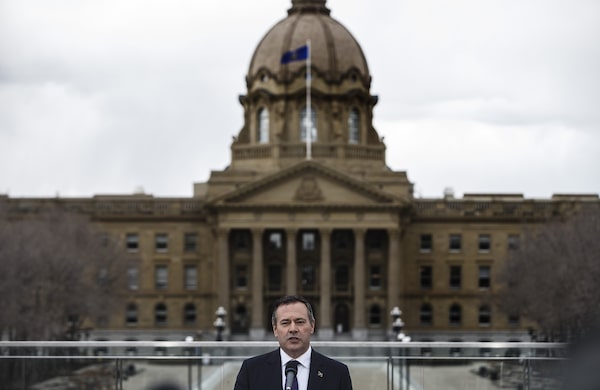Premier Jason Kenney’s government has scrapped planned changes to the province’s electricity market and will retain a deregulated power system created two decades ago.
The government’s decision won’t affect power bills in the short term, because the shift to a partly regulated market was still two years away. But experts have warned more volatile power prices could return.

The government of Premier Jason Kenney, seen the day after his election victory on April 17, 2019, has announced it will immediately put to a halt an effort to parly regulate Alberta's electricity market, a plan enacted under the previous NDP government.JASON FRANSON/The Canadian Press
Alberta’s electrical market has been an outlier in Canada since the early 2000s. Most Canadians buy power from large Crown corporations that dam rivers or split the atom. Albertans get electricity from private companies that compete among themselves. The system has been credited with getting new power stations built without public funding as the provincial economy boomed. However, bills sometimes fluctuate wildly.
By the end of 2016, Rachel Notley’s New Democrats had had enough of a power market in the hands of private competition that in recent years had produced rolling blackouts, bills that soared and then crashed and allegations that power companies looking to hike profits could game the system. They announced that the system, created during premier Ralph Klein’s drive for deregulation, was a relic.
Ms. Notley’s government drafted plans to partly regulate the market based on the model used in nearly every U.S. state.
But this week, less than three months after Mr. Kenney’s United Conservatives were voted into office, Energy Minister Sonya Savage announced that Ms. Notley’s changes, supposed to take effect in 2021 after years of tinkering, were being immediately halted. Let’s stick with what works, she said.
“The consensus was almost unanimous," Ms. Savage said. "The sector supports the energy-only market system, they say it works and we agree.”
As a stop-gap measure on the way to a regulated market, Ms. Notley’s government introduced a cap on power prices in 2017 that was meant to stay until the new electricity market was in place.
Ms. Savage confirmed earlier this week that she will consider scrapping that price cap in the fall.
A deregulated market in which power generators sell their electricity into a market and are paid the going rate is known as an “energy only” system. Producers have no guarantee they will get anything for their power, but rates can skyrocket during shortages. The system is popular in Europe. Texas is the only other jurisdiction in North America to use it.
The system the NDP had planned is known as a capacity market. The Alberta Electric System Operator, a provincial authority, was to plan for future energy demand and auction off licenses to power generators. Those licenses would guarantee that a producer would be paid even if no one wanted the power. The system ensures power is always available, at the risk of sometimes having too much.
Ms. Notley’s government said the move would end power swings in which prices could double overnight. It would also end rock-bottom prices that have lingered since the economy went into recession in 2015 after a collapse in oil prices. Private producers expecting the economic boom to continue had overbuilt and were sometimes forced to sell power at a loss.
“Albertans and investors need stability and they need certainty in their electricity market system, not an experiment. And that’s exactly what the NDP capacity market is in its early years,” Ms. Savage said.
Chief executive officers of power companies welcomed the NDP’s plan in 2016, saying the stability created by a partly regulated market would bring new investment. Nearly three years later, some of the same executives say the amount of investment needed has dropped and they prefer things as they are.
“The reason to go to a capacity market, one of the elements, was the view that we needed a more inviting market for additional investment. … That’s changed,” said Capital Power Corp. president Brian Vaasjo.
The utility has built more new electrical capacity in Alberta than any other producer over the past 15 years. According to Mr. Vaasjo, the amount of new investment needed in the system over the next few decades has fallen by more than half, to $12-billion. The reason is cheap natural gas and plans to convert Alberta’s coal-fired plants to gas.
“If you continue down the path of a capacity market, we don’t see it as investable for a couple of years and a high probably for us at Capital Power [is that] it may never be investable because of the tremendous amount of regulatory oversight,” he said.
According to Ms. Savage, the Kenney government’s plan to reduce new construction of renewable power has also cut the need for such investment.
Plans for the capacity market were also not meeting expectations, said Vittoria Bellissimo, the executive director of the Industrial Power Consumers Association of Alberta.
“The way this market was being designed was just untenable for a number of participants,” she said.
Among the concerns was the fact that producers had expected regulation to be minimal, but a number of provincial agencies increased their staffing levels to look at and question applications for licenses. She said that would increase the complexity and price of the system.
She also said a focus on having excess energy to ensure a steady supply would drive up bills.
We have a weekly Western Canada newsletter written by our B.C. and Alberta bureau chiefs, providing a comprehensive package of the news you need to know about the region and its place in the issues facing Canada. Sign up today.
 Justin Giovannetti
Justin Giovannetti